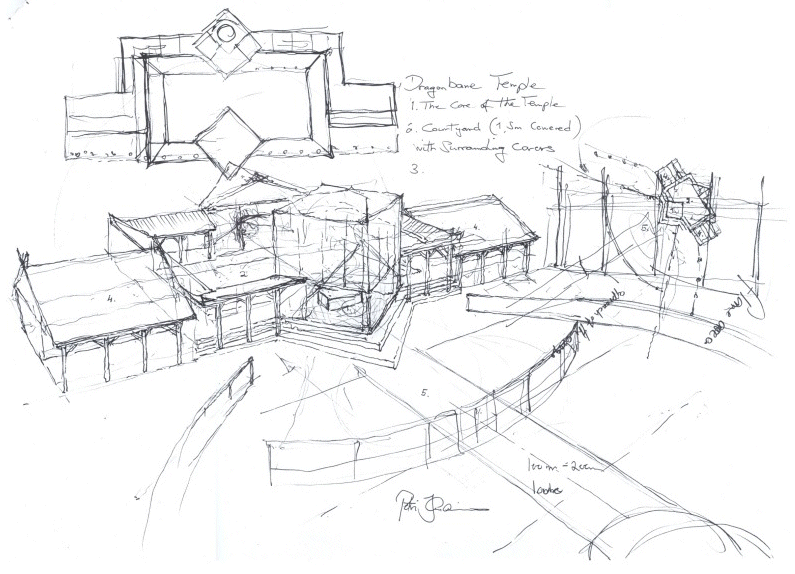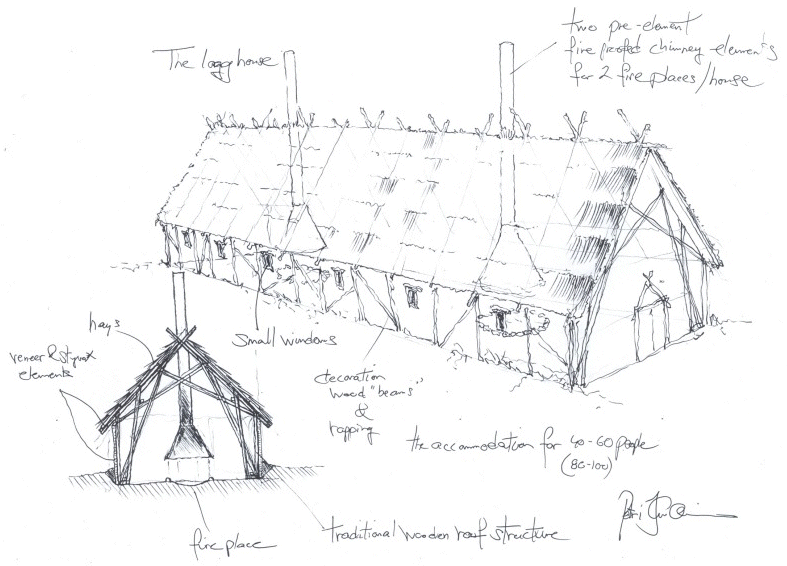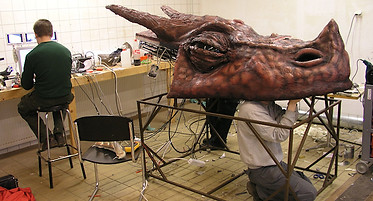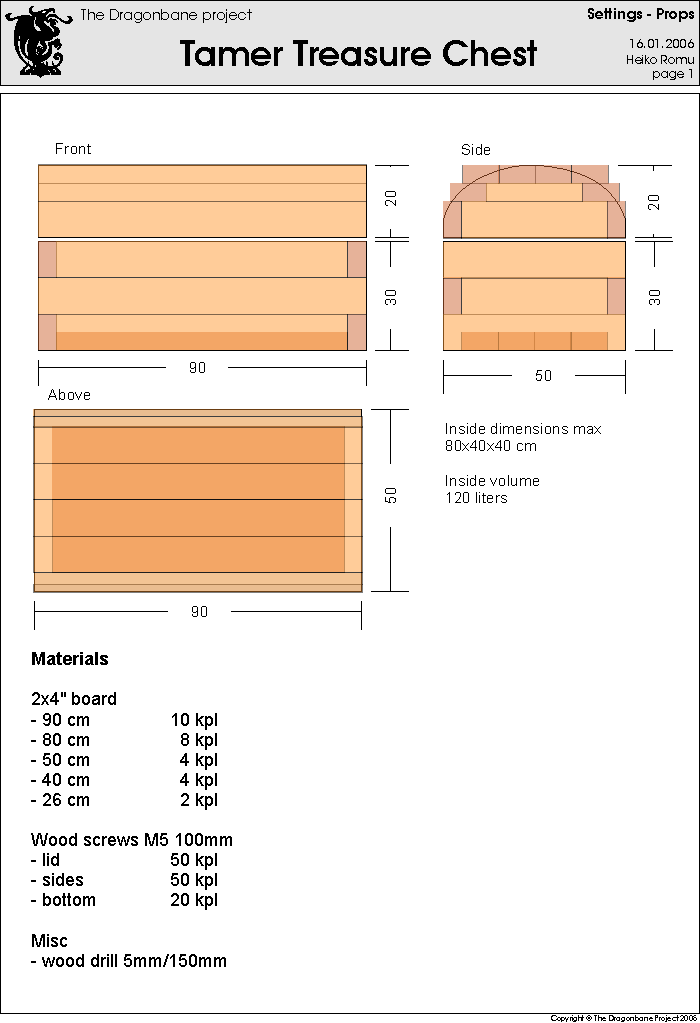
Dragonbane - international theatre production
Dragonbane was a very large international amateur theatre project. The event took place from July 27 to August 4, 2006 in Älvdalen in Sweden. There were 325 partakers in the event and almost 200 persons in the preparation teams. The total budget for the project was almost 1 million euros, with most of the funding coming from corporate sponsors like Hewlet-Packard. Dragonbane was a very ambitious project taking almost three years to complete. The builder crews had people from 15 different countries, all of them being volunteers, hobbyists, students and other enthusiasts. (Wikipedia)

Production Design
Fýr Romu was main set designer for the project. The objective was to create the most immersive setting ever seen in third-person-audience event. In total approx. 150 people worked in the settings teams intermittently for two years.
The teams started to build a real-sized mediaval village for 700 persons, an animatronic super-large dragon puppet and design the culture and material environment for all the three social groups of the story. The special effects group´s objective was to create working, visible magic system for the fantasy world. Also, a Logistics team planned the everyday living arrangements for several hundreds of people for a week - with hygiene, transportation and authentic medieval-style food.
The final response to the event was mixed. The setting was universally praised as having very high standards of immersion and details, but organizational and technical flaws in the performance gained negative critical responses.
Groups and people
The set builder people were divided to several teams, the largest being Village, Dragon, Costume and Props. Effects, Safety, Logictics and Data teams supported the work. Total man-hour count was over 150.000 hours in three years.
Village building
The village had 12 houses, including a temple, a forge, a sauna, a working bakery and four winter-habitable longhouses for 100 persons each.









3D-visualization compared to a satellite image


Building the village took approximately six months, divided into summer periods, to allow a large voluntary international work force. Buildings were designed by Fýr Romu and professional architect Petri Ilmarinen. Several professional builders and construction students supervised the actual work.
Village was economically the largest part of the set, with budget over 100.000€. Strict environmental and hygiene regulations of the Swedish government had to be met, causing a lot of research and documenting work. Also, fire safety was essential, as the village had a dozen working fireplaces. Sauna´s large wooden swimming pool had a double role as extinguishing water reservoir. The general outlook of the village (Cinderhill people), and for the two other fictional social groups Dragontamers and Witches, was based on main writer Mike Pohjola´s literary work Valenor. The artistic vision was regularily approved by the writer.
 |
|---|
 |
 |
 |
 |
 |
 |
 |
 |
 |
 |
 |
 |
 |
 |
 |
 |
 |
 |
 |
 |
Dragon
The dragon was the largest prop item for the event. The event writers wanted it to be as large as a ´real´dragon - so it was based on a 15-ton Ponsse log loader. A hydraulic skeleton was build over the machine, covered with rubber skin. Moving head, tail, legs and wings were computer-controlled. The dragon was build with heavy sponsoring from several high-tech companies, in addition of a budget of 50.000€. It was designed by Fýr Romu, main engineer Eero Alasalmi and a very talented groups of tech students and professionals from several Finnish, Swedish and Estonian universities.





The dragon´s face had individually controlled pneumatic muscles and servo-controlled actuators, making facial expressions possible. These were controlled with a computer touch screen. The head had a fog machines with pyrotechnic units for the dragon´s breath. The eyes and the body contained a dozen cameras, making interaction and safe moving possible. Driving the 20-ton pupped was a safety hazard, so radio-connected safety operators were always assisting the driver. The dragon was operated by two persons - one playing the character, with computer-enchanced voice, the other was a driver, responsible for safe moving. Additional special effect persons supervised using the effects devices.
 |
|---|
 |
 |
 |
 |
 |
 |
 |
 |
 |
 |

Costumes and Propping
The village was filled with thousands of props, including also wintertime equipment to make the habitation more believable. Large amount of custom props were designed and manufactured by the Props teamp. This included curious items like a huge ballista and an alchemical laboratory with chemicals. The Costume team designed styles for all the three cultures. All costumes were patterned and detailed instructions were delivered for the partakers.




 |
|---|
 |
 |
 |
 |
 |
 |
 |
 |
 |
 |
Project Planning and Management
Project planning begin, with the story writing, about half a year before actual building started. There was a main design group controlling the cooperation of artists, writers, technicians, artesans and other creative people. Basic requirements were agreed in an early phase: the buildings, props, cultural items like songs, food reciles and stories, technical items and safety accessories.

As almost all work was done by volunteers, sometimes this was very difficult and timetables were constantly changing. Large adjustments were needed and most final flaws of the event resulted from this. However, the organization structure still worked relatively well and the teams were able to concentrate to their creation. In total, over 150.000 email messages were archived by the leader team..
The total duration of the project was a little over three years, with the last half year used for cleaning, accounting and final reporting, which many of the financial supporters required. A large, 176-page book with hundreds of photos was created. The book is available via the Finnish public library system.
Publicity
The project naturally caused and required large exposure. Printed media, tv and radio interviews were almost continuous, including whole-page stories in Finland´s largest newspaper. The project team also produced several advertisement videos for the event.


Project workers by nationality

Published final report:
ISBN: 978-952-67100-6-8
176 pages, 2007
